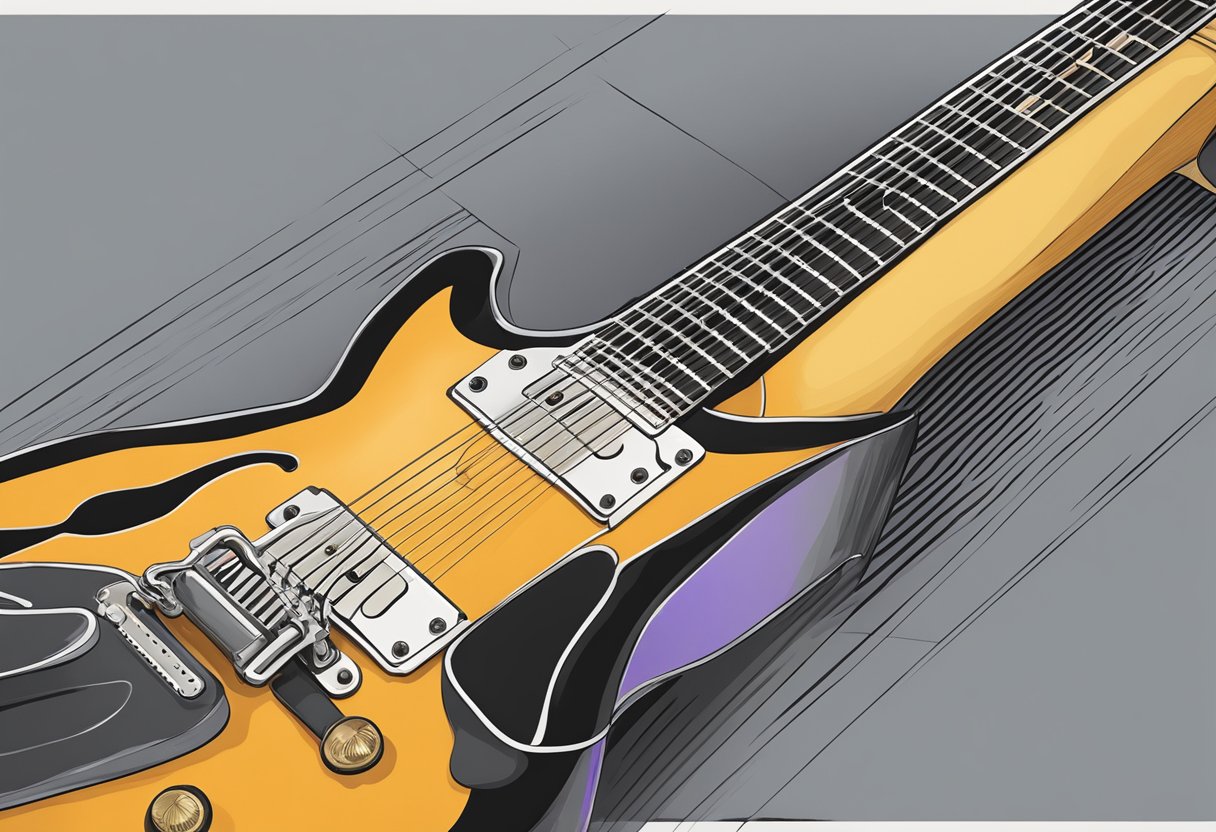How to Wear a Guitar Strap: Ensuring Comfort and Style
Wearing a guitar strap properly is essential for the comfort and playability of any guitarist. Whether playing an electric or acoustic guitar, the strap is a critical accessory that allows musicians to maintain the instrument in an optimal position while standing. The right strap height and fit ensure that the player can reach the strings and frets with ease, contributing to better technique and preventing strain or injury.

Adjustment of the guitar strap is a personal preference and can vary widely between players. Some prefer the guitar positioned high for closer access to the fretboard, while others opt for a lower placement, often inspired by famous guitarists. The choice of strap position often depends on playing style, guitar type, and ergonomic considerations. Both high and low positions have their advantages and should be chosen based on what feels natural and allows for the best control over the instrument.
When attaching the strap, it’s important to secure it properly to prevent the guitar from slipping or falling. Most guitars come equipped with strap buttons where the strap can be easily attached. Ensuring the strap is fastened securely offers peace of mind and allows the musician to focus on playing, whether they’re practicing at home or performing on stage.
Want to see the latest guitar accessories that are popular right now? Just click here!
Understanding Guitar Strap Types
Different straps cater to the varied needs of guitarists, including comfort levels, instrument weight, and personal style preferences.
Standard Straps
Standard straps are the most common type and feature a simple design suitable for most guitars. They typically have:
- Adjustable lengths to accommodate different player heights
- Widths ranging from 2 to 4 inches for comfort
- Materials like nylon, leather, or cotton
Ergonomic Straps
Ergonomic straps are designed to reduce stress and fatigue on the shoulder and back by distributing the weight of the instrument more evenly. They often include features such as:
- Padded shoulders for extra comfort
- Contoured shapes to fit the body better
- Stretchable materials that allow for some give
Custom Straps
Custom straps allow individuals to express their style, and they are often handmade or tailored to specific requirements. These straps may include:
- Personalized lengths and widths for a perfect fit
- Unique materials like exotic leathers, suede, or artist-designed fabrics
- Custom graphics, embroidery, or embossing for a personal touch
Selecting the Right Strap
When choosing a guitar strap, the player must consider material durability, comfort level, strap length and width, and the compatibility with strap locks to ensure a secure and stable fit.
Material Considerations
The material of a guitar strap significantly affects both comfort and performance. Leather straps are durable and can provide a classic look, but they may be more expensive. Nylon straps are lightweight and typically less costly, with the added benefit of being adjustable and available in various designs. Cotton straps offer breathability, which can be beneficial during long playing sessions.
Length and Width
A guitar strap must have an adjustable length to accommodate different player heights and playing styles. Standard straps usually range from 40 to 60 inches in length. The width of the strap is also important; wider straps distribute weight more evenly, reducing shoulder fatigue. Straps generally vary in width from about 2 to 4 inches. Players should select a width that balances comfort with the instrument’s weight.
Strap Locks Compatibility
Strap locks are a safety feature that secures the strap to the guitar, preventing accidental drops. Players should ensure the strap ends are compatible with strap locks. Most straps can be fitted with aftermarket strap locks, but some come with built-in strap lock systems. It is essential to check that the chosen strap locks are compatible with the guitar’s existing buttons or if they require replacement buttons to be installed.
Adjusting the Strap for Comfort
Ensuring comfort while playing the guitar hinges on properly adjusting the guitar strap to suit one’s body and playing style.
Determining the Ideal Height
The guitarist should strive for a strap height that allows for a natural arm position and minimal shoulder strain. This is achieved when the guitar rests in the same position whether sitting or standing. The guitarist’s fretting hand should easily reach all frets without stretching, while the picking hand should be able to strum or pluck strings comfortably.
Adjusting the Strap Length
To adjust the strap length:
- Identify the adjustment mechanism: Most straps have a buckle or a sliding adjuster.
- Modify the length and test: Lengthen or shorten the strap, then wear the guitar to test the feel. It might take several small adjustments to find the perfect length.
A well-adjusted strap contributes significantly to the guitarist’s technique and comfort, enhancing their ability to play without physical hindrance.
Attaching the Strap to the Guitar
Before playing the guitar, it is essential to properly attach the strap to ensure the instrument is secure and to maintain a comfortable playing posture.
Acoustic Guitars
Most acoustic guitars feature one strap button at the bottom end of the body and may have a second button at the top of the body near the base of the neck. If the acoustic guitar has two pins:
- Locate the buttons: One is near the base of the body, the second at the heel of the neck.
- Attach the strap: Slide the strap’s holes over the buttons, making sure it’s snug and secure.
If there’s only one button, the strap needs to be tied at the neck:
- Tie the strap: Loop a string through the strap’s hole and tie it around the headstock, above the nut, and below the tuning keys.
Electric Guitars
Electric guitars typically come with two strap buttons located at the bottom of the body and on the upper body bout or on the horn of the guitar.
- Position the strap: Align the strap holes with the buttons on the body.
- Secure the strap: Firmly push the holes over the buttons to ensure the strap is tightly fastened.
Classical Guitars
Classical guitars usually do not come equipped with strap buttons due to the traditional playing position and construction.
- Attachment methods: Players often use a strap that has a hook or a suction device to connect to the soundhole, or they might need to install buttons if preferred.
Attaching a guitar strap to a classical guitar often requires additional accessories or a special type of strap designed for guitars without buttons.
Maintaining Your Guitar Strap

Proper maintenance of a guitar strap is essential for ensuring longevity and performance. A well-maintained strap provides comfort and stability while playing.
Cleaning the Strap
Guitar straps can accumulate sweat, dust, and grime with regular use. For nylon straps, use a mild soap and warm water, then allow them to air dry. Leather straps require specific leather cleaners to preserve their natural oils; after cleaning, one should condition the leather to keep it supple.
Storage Tips
When not in use, storing the guitar strap correctly is key to preventing wear and tear. Keep the strap in a cool and dry place to avoid moisture damage. If possible, hang the strap or lay it flat to prevent creases or folds, especially for leather straps which can crack over time when improperly stored.
Regular Inspection
Regularly inspect the strap for signs of wear, such as frayed edges or weakened strap holes. Pay attention to the strap buttons and locks, if applicable, to ensure they have not become loose, as this could result in the guitar falling. Any issues should be addressed promptly to avoid further damage.
Troubleshooting Common Issues
When wearing a guitar strap, musicians may encounter issues such as strap slippage and discomfort. Identifying and addressing these problems enhances playing comfort and performance stability.
Strap Slippage
Strap slippage occurs when a guitar strap fails to hold onto the strap pins securely, leading to the guitar moving or dropping unexpectedly. To prevent this, one can:
- Use strap locks: Replace the existing strap pins with strap locks that clamp the strap in place.
- Add rubber washers: As a temporary fix, use rubber washers or gaskets from a hardware store to fit over the strap pins, securing the strap end.
Strap Discomfort
Strap discomfort often arises from an improperly adjusted strap or the use of a strap that does not evenly distribute the weight of the instrument. The musician should:
- Adjust the strap length: Ensure the guitar sits at a comfortable height where the fretting hand can reach all positions without straining.
- Select a padded strap: Opt for a wider, padded strap to reduce pressure on the shoulder.
- Reposition regularly: Shift the guitar’s position slightly during long playing sessions to prevent localized fatigue.
Enhancing Strap Performance and Aesthetics

The right guitar strap not only supports the instrument but also reflects a player’s style. This section details how to add both functional and decorative enhancements to a guitar strap.
Decorative Elements
Decorative elements can transform a guitar strap from a mere support accessory into a personalized statement piece. Musicians can choose from various additions such as:
- Engravings: Fine leather straps can be engraved with patterns or initials.
- Conchos: Metal embellishments, often with a Western flair.
- Embroidery: Intricate thread patterns for a unique look.
- Pins and Badges: Musicians often attach these to their straps as a form of self-expression related to bands, brands, or causes.
Functionality Upgrades
A guitar strap should be more than just visually appealing; it should also enhance the playing experience. The following upgrades improve strap performance:
- Locking Mechanisms: Strap locks secure the strap to the guitar, preventing accidental drops.
- Padding: Extra padding increases comfort, especially for heavier instruments or longer playing sessions.
- Adjustability: A slider or buckle allows for quick and precise length changes.
- Pocket Pouch: A small pouch or pick holder sewn into the strap keeps picks handy.





![Why Do Barre Chords Hurt? [Reasons Explained]](https://i0.wp.com/joneruizguitar.com/wp-content/uploads/2022/10/5-768x432.png)
